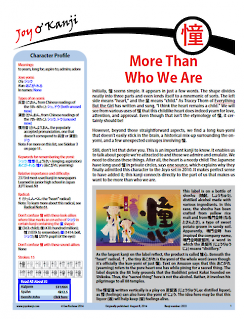憧
to yearn, long for; aspire to; admire; adore
Kanji 2033
Thank you for visiting this Character Home Page. Below you'll find a synopsis of the essay. If you wish to read the full text, the PDF of the essay is available for purchase to the right.
This kanji enables us to talk about people we find hot, the professionals we admire, and the celebrities we worship. We can also use it to convey our yearning for a lifestyle (urban or rural), our dreams for the future (and how 夢 differs in this respect), and our longing for the past. See how the Japanese freely coin terms with 憧, leaving even native speakers uncertain about the yomi.
Revision History:
Feb. 3, 2023: p. 11: In the definition of 駆り立てる, I deleted the reference to the passive voice, as the verb is in its past-progressive form.
June 2, 2021:
- p. 2: Added the Henshall etymology.
- p. 2: Redefined 好き as “fond.”
- p. 6: Slightly updated Henshall’s etymology of 焦.
- p. 14: Added a link to the Kanshudo games.
Feb. 17, 2017: In writing essay 1997 on 憬, which has a lot of overlapping material, I revisited vast portions of essay 2033 and ended up making more changes than I can list here. These are the bigger ones:
p. 2: Removed an unnecessary word from the sample sentence about the human soul.
p. 3: Added a missing word to my commentary, changed the definition of 少々 in the "I sometimes wish ..." sentence, removed an unnecessary word from the sample sentence translated as "Many young people ...," and added 生活 to the sentence about elementary school.
p. 4: Deleted unnecessary words from the "We look back ... " sentence, changed the definitions of 一種 and 抱く, and modified the translation of the sentence about talent.
p. 5: Slightly changed the translation of the sentence about a favorite author’s work.
p. 10: Revised the part about what inspired the Japanese to create the compound 憧憬.
p. 11: Made slight changes to the translation of the last sample sentence, which is by Chokodo, whose pen name I've now rendered like that.
June 12, 2015: p. 11: A rare kanji in the ドウ line wasn't visible in the PDF, instead appearing as a box. Now you can see the character.
Aug. 8, 2014: Originally published.



Comments